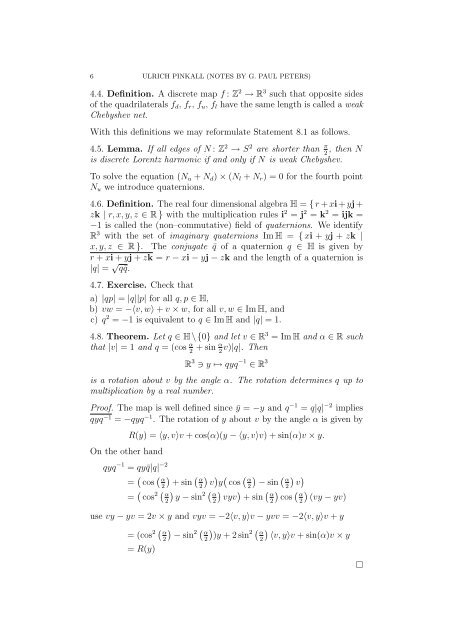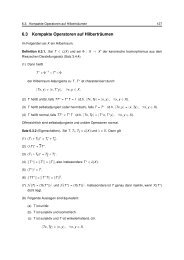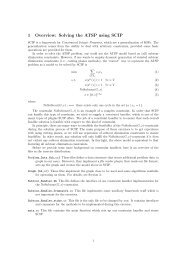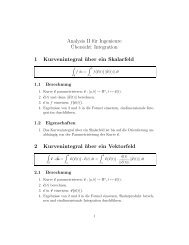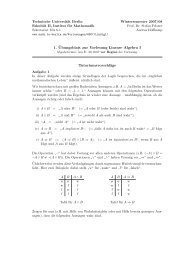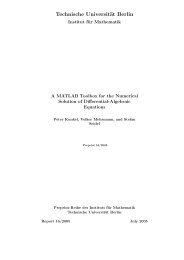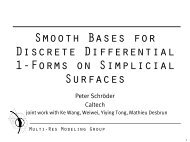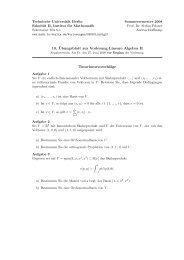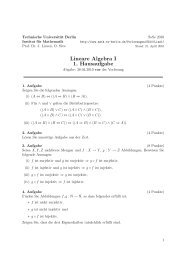Lecture notes - Institut für Mathematik - TU Berlin
Lecture notes - Institut für Mathematik - TU Berlin
Lecture notes - Institut für Mathematik - TU Berlin
You also want an ePaper? Increase the reach of your titles
YUMPU automatically turns print PDFs into web optimized ePapers that Google loves.
6 ULRICH PINKALL (NOTES BY G. PAUL PETERS)4.4. Definition. A discrete map f : Z 2 → R 3 such that opposite sidesof the quadrilaterals f d , f r , f u , f l have the same length is called a weakChebyshev net.With this definitions we may reformulate Statement 8.1 as follows.4.5. Lemma. If all edges of N : Z 2 → S 2 are shorter than π 2 , then Nis discrete Lorentz harmonic if and only if N is weak Chebyshev.To solve the equation (N u + N d ) × (N l + N r ) = 0 for the fourth pointN u we introduce quaternions.4.6. Definition. The real four dimensional algebra H = { r + xi + yj +zk | r, x, y, z ∈ R } with the multiplication rules i 2 = j 2 = k 2 = ijk =−1 is called the (non–commutative) field of quaternions. We identifyR 3 with the set of imaginary quaternions Im H = { xi + yj + zk |x, y, z ∈ R }. The conjugate ¯q of a quaternion q ∈ H is given byr + xi + yj + zk = r − xi − yj − zk and the length of a quaternion is|q| = √ q¯q.4.7. Exercise. Check thata) |qp| = |q||p| for all q, p ∈ H,b) vw = −〈v, w〉 + v × w, for all v, w ∈ Im H, andc) q 2 = −1 is equivalent to q ∈ Im H and |q| = 1.4.8. Theorem. Let q ∈ H \ {0} and let v ∈ R 3 = Im H and α ∈ R suchthat |v| = 1 and q = (cos α + sin α v)|q|. Then2 2R 3 ∋ y ↦→ qyq −1 ∈ R 3is a rotation about v by the angle α. The rotation determines q up tomultiplication by a real number.Proof. The map is well defined since ȳ = −y and q −1 = q|q| −2 impliesqyq −1 = −qyq −1 . The rotation of y about v by the angle α is given byOn the other handR(y) = 〈y, v〉v + cos(α)(y − 〈y, v〉v) + sin(α)v × y.qyq −1 = qy¯q|q| −2= ( cos ( ) (α2 + sin α) ) ( (2 v y cos α) (2 − sin α) )2 v= ( cos ( ) ( ) ) ( 2 α2 y − sin2 α2 vyv + sin α) (2 cos α)2 (vy − yv)use vy − yv = 2v × y and vyv = −2〈v, y〉v − yvv = −2〈v, y〉v + y= (cos ( 2 α2= R(y))− sin2 ( α2))y + 2 sin2 ( α2)〈v, y〉v + sin(α)v × y□


